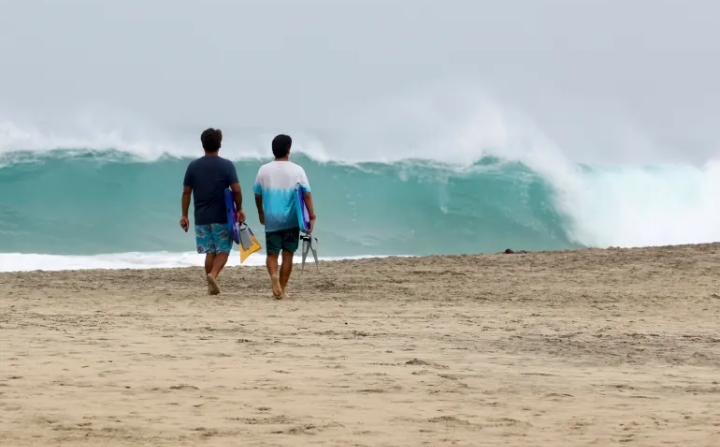Hurricane Erick, now a Category 4 storm with 145 mph winds, is set to hit Mexico’s Pacific coast Thursday. Authorities warn of floods, mudslides, and strong winds. Shelters are open, schools closed, and evacuations urged in high-risk areas.
Mexico Braces as Hurricane Erick Intensifies to Category 4 Ahead of Landfall


Hurricane Erick was officially upgraded to a Category 4 hurricane early Thursday morning, prompting heightened alerts along Mexico’s Pacific coastline. Authorities and residents alike are bracing for the powerful storm's imminent landfall, as it continues to gather strength and threaten widespread damage.
The hurricane, which is now carrying maximum sustained winds of 145 miles per hour (230 kilometers per hour), is currently advancing in a northwesterly direction at a speed of 9 miles per hour (15 kilometers per hour). This dramatic escalation in intensity over a short period classifies Erick as an “extremely dangerous” Category 4 storm, according to the United States National Hurricane Center (NHC). The rapid strengthening is particularly concerning to meteorologists, who have noted the storm's swift transformation from a relatively weaker Category 1 hurricane just a day earlier.
Late Wednesday night, Erick’s projected trajectory shifted slightly southward. According to the latest advisory issued by the NHC, the storm’s center is now expected to make landfall along the western portion of the Mexican state of Oaxaca or the eastern portion of the neighboring state of Guerrero. The agency added that landfall is anticipated to occur by Thursday morning, after which the system will likely continue its movement inland across southern Mexico throughout the day.
Forecasters have cautioned that Erick may intensify even further before making landfall. Once it moves over land, however, it is expected to gradually weaken due to reduced moisture and friction from the terrain. Nevertheless, the threat of severe damage remains high.
The NHC has also reiterated earlier warnings about the potential for “damaging winds and life-threatening flash floods” across parts of southern Mexico. The combination of heavy rainfall, powerful winds, and unstable terrain could lead to catastrophic consequences in vulnerable areas.
With the storm expected to bring intense and sustained rainfall, particularly in the states of Oaxaca and Guerrero, officials are especially concerned about the risk of deadly flooding and mudslides. These regions are known for their mountainous landscapes and numerous rivers, making them particularly susceptible to natural disasters during heavy storms.
President Claudia Sheinbaum has urged residents in flood-prone zones—especially those living in low-lying areas or close to rivers and hillsides—to evacuate and take refuge in designated emergency shelters. In preparation for the storm, authorities have established approximately 2,000 temporary shelters across both Guerrero and Oaxaca. Hundreds of soldiers, emergency response teams, and utility workers have been mobilized and are on standby to assist in rescue operations and infrastructure repairs in the aftermath of the storm.
In the city of Acapulco, a popular port and tourist destination renowned for its beaches and vibrant nightlife, local police have taken to patrolling the streets and shoreline to alert both residents and visitors. Loudspeakers and vehicle-mounted megaphones are being used to warn people to stay indoors, prepare for potential evacuations, and monitor official updates closely.
The governor of Guerrero, Evelyn Salgado, announced on Wednesday that all schools in the state would remain closed until further notice to ensure the safety of students, staff, and families. She also emphasized the importance of heeding government instructions and not underestimating the storm’s potential impact.
Hurricanes are not uncommon in Mexico, particularly between the months of May and November, which marks the annual hurricane season affecting both the Atlantic and Pacific coasts. Each year, the country faces several strong tropical systems, some of which result in devastating losses.
In September 2024, for instance, Storm John—a Category 3 hurricane—struck parts of Mexico, claiming the lives of 15 people and causing extensive property damage. Just a year earlier, in October 2023, Acapulco suffered one of the most destructive storms in recent history when Hurricane Otis, a Category 5 storm, made landfall. That hurricane left a trail of destruction and was responsible for at least 50 confirmed deaths, underscoring the grave threat posed by such natural disasters.
With memories of recent storms still fresh, and Erick gaining strength by the hour, Mexican authorities and citizens remain on high alert, preparing for what could be one of the most dangerous storms to hit the region this year.

 বাংলা
বাংলা  Spanish
Spanish  Arabic
Arabic  French
French  Chinese
Chinese 
